Ruger’s Classic Model 77 Rifle Review
By Bob Campbell
©Copyright Precision Shooting Magazine
If I were to pick the most influential bolt action rifle of all time, what would it be? The Lee Enfield may be the greatest battle rifle and the Springfield 1903 first in our hearts and minds, but the Mauser rifle is by far the most influential. By the same token there are quite a few rifles today that are based on the Mauser action but they are considerably better than the original as far as the steels used. They are also good all around rifles for practical use. When I look at a Mauser action the first thing I like to see is the real deal, real Mauser features. I do not wish the maker to merely claim the rifle is a Mauser action. The claw extractor is among the first things to look for and the defining characteristic of a Mauser action. The controlled feed action takes control of the cartridge and does not let it waver from its path through chambering, firing and extraction. There are some actions that pay lip service to the claw extractor and do not include the original rotating foot in the bolt body. Among the modern rifles that follow Mauser’s idea of a good design is a Ruger M 77. The Ruger is rugged, smooth enough, usually features good wood, and has a reputation for acceptable accuracy. I have enjoyed good service with Ruger rifles although I admit that true precision accuracy was sometimes lacking. They got the job done, but were not the proverbial tack driver. They were good enough, and perhaps a bit more. Besides, for those who purchased them, and the autumn woods are filled with hunters toting their Model 77s each year. Few of them are less than satisfied with their selection. The Ruger Model 77 deviates from the Mauser in several ways that I find acceptable. The original Mauser safety, as an example, was a model of perfection until you attempted to mount a scope. The Ruger system mounts the safety on the right side of the receiver. This is a superior set up for a hunting rifle.
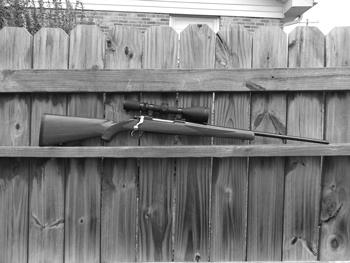
The Ruger simply looks right, with good wood, a good stock design and a classic bolt action receiver and bolt.
When I learned that the Ruger was available in 6.5 x 55 Swedish Mauser chambering I knew that I had to explore this combination. The 6.5 Swede is among the best balanced, accurate, and light kicking game loads of all time. But when coupled with the Ruger action the cartridge may be loaded a bit hotter than with the original Mauser. The result is an excellent all around deer sized game killer that outpaces the original – although the original loading has long enjoyed a good reputation in the field. Finding the rifle proved to be a chore. I looked around the area for several months and even coasted the Internet. Evidently the rifle isn’t something that Ruger produces on a regular basis. And, then too, I am loathe to order a new rifle when a good used rifle may be found at a forty percent discount or more. Then, one day, when I was actually looking for something else I saw a Model 77 with the tag “6.5 mm” on the rack at a pawn shop. (Editor: Our writers often make reference to being in pawn shops. This is done primarily to show me that we are not paying them enough, and they are just one step from the poor house.) The rifle was purchased for less than four hundred dollars and taken home for a little preparation before heading to the range. This preparation will mean a lot once you get to the rifle range.
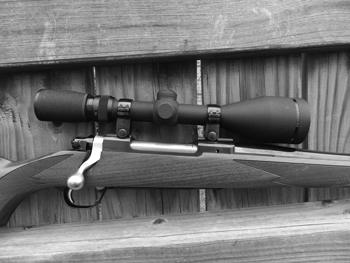
The Simmons 3.5 x 10 x 50mm scope isn't overkill with this rifle. The 6.5 x 55mm Mauser is a grand old cartridge for long range work.
First, I checked the scope. The rifle was fitted with a Simmons 3.5 x 10 x 50mm. Ok, plenty of glass for this rifle. The objective lens gave good clarity and the exit pupil was more than adequate. The crinkle black finish was attractive in a functional way. While not an expensive scope the Simmons proved to work just fine. I checked both mounts and bases and all screws were tight. Next, I checked the stock and action screws to be certain that all of these screws were tight. The action screws and scope mount and base were checked and double checked. After some experience with the Ruger rifle I realized that the stock sometimes rides too close to the barrel. The initial firing test was conducted with Wolf ammunition. Even though Wolf is usually the cheapest ammunition available, accuracy was acceptable and the powder burned clean. The loads were darned consistent. I don’t trust the bullet to expand without considerable testing so I do not use these as hunting loads, but the Wolf cartridges are more than accurate enough for meaningful practice. However, there was room for improvement in the rifle. Past experience has shown that the most common cause of poor accuracy with Ruger rifles is the fore-end contacting the barrel. I disassembled the rifle, free floated the barrel using Brownells’ Acra Glas compound, and I was back in business. This effort proved well worth my time.
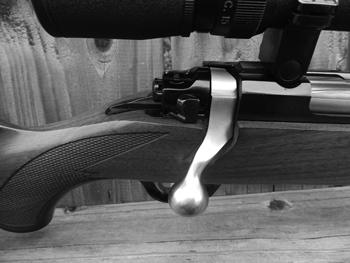
While the Ruger safety is a deviation from the Mauser's bolt mounted safety it allows good scope clearance. This is a positive safety well suited to hunting rifles.
Let’s discuss the 6.5mm cartridge. The 6.5 x 55mm Swedish Mauser is a hoary old cartridge that predates even the .30-06. It was designed at a time when smokeless powder was making fast shooting guns possible, including not only rapid fire magazine fed bolt guns but also machine guns. Since Sweden numbered Alfred Nobel among its citizens, smokeless powder research ran along at a brisk rate. The 6.5 came along at a time when there were no trucks to carry troops and no airplanes. This made for some interesting reality. Here we have a modern smokeless powder cartridge designed to kill men at long distances – and disable horses. It might not knock a horse down like a .45 –70 would but a horse hit with such a bullet would stop working! And penetration was excellent, so with minute of mule accuracy the 6.5 x 55 could prove deadly. The cartridge was light, which meant lots of them could be carried, and recoil was light as well, which meant higher proficiency for less practice. The original loading was good for 139 grains at about 2400 fps. This doesn’t seem like high velocity by modern standards but there is more to the story. The long, heavy for the caliber, bullet exhibited excellent penetration. At the time the performance was cutting edge. And therein lies another tale.
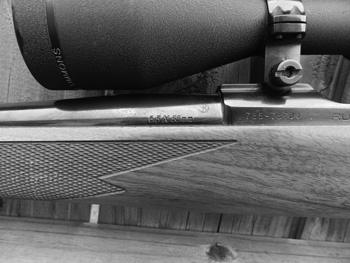
The caliber marking, 6.5 x 55mm, is by no means common in America, but a few enthusiasts keep the cartridge alive.
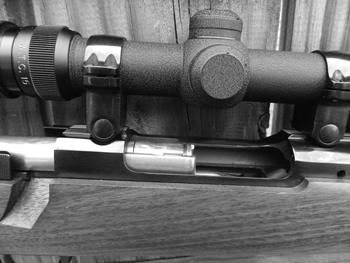
The Ruger scope bases are models of good function. The bolt is open, exposing the claw extractor.
American ammunition companies such as Winchester and Federal load the 6.5 with a 139 to 140 grain bullet at about 2500 fps. The bullet has good sectional density and is long and heavy for the caliber. It penetrates well and kills animals well with good shot placement. It is something of a wonder caliber, with light recoil but real effect on game. But the loads are generally designed for use in the ancient Mauser action. The original Mauser may not blow up with a heavier load but it will wear much more quickly. A savvy handloader may up the ante a minimum of 100 fps. This supercharging could be useful in some hunting situations. At present the major makers offer good quality ammunition with adequate hunting bullets. My pick is the Hornady Superperformance at some 2700 fps with the SST bullet. That is quite a load and one that maximizes the caliber. Hornady also offers a traditional load for accuracy and for use in the Mauser rifle, but the Supermax is the first choice for hunting in the Ruger and other modern rifles. Firing from a solid bench rest I was able to secure several excellent groups from the Ruger/ 6.5mm combination. However, some observations are in order. First, accuracy is very good but really no better than any other Ruger M 77 that is properly bedded. The .308 is at least as accurate. The .243 is also as accurate. The 6.5 x 55’s long suit is good accuracy and low recoil. Well, it doesn’t kick like a .30-06 but the laws of physics are at play here. With 140 grains at 2700 fps the 6.5 will recoil nearly as much as a .308 with 150 grains at the same gait. The 6.5 does have modest recoil and it is accurate, but it is not as soft shooting as a .243 Winchester. Still I like the 6.5. It is not necessarily something I would pay big bucks for in a custom rifle. But since it landed in my hands easily enough I used it and find it a good caliber. The reputation of the cartridge is the field is unassailable. It is a deer killer due to a combination of deep penetration, a good expanding bullet and I suspect the easy road to marksmanship with less recoil than the .30 battle rifles. All in all a fine cartridge and a great rifle and a good combination for those who like performance and despise recoil.
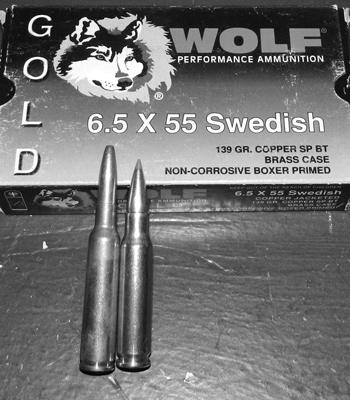
The 6.5 x 55mm is compared to a .308 Winchester. It is quite a round for its size.

By Bob Campbell
©Copyright Precision Shooting Magazine
If I were to pick the most influential bolt action rifle of all time, what would it be? The Lee Enfield may be the greatest battle rifle and the Springfield 1903 first in our hearts and minds, but the Mauser rifle is by far the most influential. By the same token there are quite a few rifles today that are based on the Mauser action but they are considerably better than the original as far as the steels used. They are also good all around rifles for practical use. When I look at a Mauser action the first thing I like to see is the real deal, real Mauser features. I do not wish the maker to merely claim the rifle is a Mauser action. The claw extractor is among the first things to look for and the defining characteristic of a Mauser action. The controlled feed action takes control of the cartridge and does not let it waver from its path through chambering, firing and extraction. There are some actions that pay lip service to the claw extractor and do not include the original rotating foot in the bolt body. Among the modern rifles that follow Mauser’s idea of a good design is a Ruger M 77. The Ruger is rugged, smooth enough, usually features good wood, and has a reputation for acceptable accuracy. I have enjoyed good service with Ruger rifles although I admit that true precision accuracy was sometimes lacking. They got the job done, but were not the proverbial tack driver. They were good enough, and perhaps a bit more. Besides, for those who purchased them, and the autumn woods are filled with hunters toting their Model 77s each year. Few of them are less than satisfied with their selection. The Ruger Model 77 deviates from the Mauser in several ways that I find acceptable. The original Mauser safety, as an example, was a model of perfection until you attempted to mount a scope. The Ruger system mounts the safety on the right side of the receiver. This is a superior set up for a hunting rifle.

The Ruger simply looks right, with good wood, a good stock design and a classic bolt action receiver and bolt.
When I learned that the Ruger was available in 6.5 x 55 Swedish Mauser chambering I knew that I had to explore this combination. The 6.5 Swede is among the best balanced, accurate, and light kicking game loads of all time. But when coupled with the Ruger action the cartridge may be loaded a bit hotter than with the original Mauser. The result is an excellent all around deer sized game killer that outpaces the original – although the original loading has long enjoyed a good reputation in the field. Finding the rifle proved to be a chore. I looked around the area for several months and even coasted the Internet. Evidently the rifle isn’t something that Ruger produces on a regular basis. And, then too, I am loathe to order a new rifle when a good used rifle may be found at a forty percent discount or more. Then, one day, when I was actually looking for something else I saw a Model 77 with the tag “6.5 mm” on the rack at a pawn shop. (Editor: Our writers often make reference to being in pawn shops. This is done primarily to show me that we are not paying them enough, and they are just one step from the poor house.) The rifle was purchased for less than four hundred dollars and taken home for a little preparation before heading to the range. This preparation will mean a lot once you get to the rifle range.

The Simmons 3.5 x 10 x 50mm scope isn't overkill with this rifle. The 6.5 x 55mm Mauser is a grand old cartridge for long range work.
First, I checked the scope. The rifle was fitted with a Simmons 3.5 x 10 x 50mm. Ok, plenty of glass for this rifle. The objective lens gave good clarity and the exit pupil was more than adequate. The crinkle black finish was attractive in a functional way. While not an expensive scope the Simmons proved to work just fine. I checked both mounts and bases and all screws were tight. Next, I checked the stock and action screws to be certain that all of these screws were tight. The action screws and scope mount and base were checked and double checked. After some experience with the Ruger rifle I realized that the stock sometimes rides too close to the barrel. The initial firing test was conducted with Wolf ammunition. Even though Wolf is usually the cheapest ammunition available, accuracy was acceptable and the powder burned clean. The loads were darned consistent. I don’t trust the bullet to expand without considerable testing so I do not use these as hunting loads, but the Wolf cartridges are more than accurate enough for meaningful practice. However, there was room for improvement in the rifle. Past experience has shown that the most common cause of poor accuracy with Ruger rifles is the fore-end contacting the barrel. I disassembled the rifle, free floated the barrel using Brownells’ Acra Glas compound, and I was back in business. This effort proved well worth my time.

While the Ruger safety is a deviation from the Mauser's bolt mounted safety it allows good scope clearance. This is a positive safety well suited to hunting rifles.
Let’s discuss the 6.5mm cartridge. The 6.5 x 55mm Swedish Mauser is a hoary old cartridge that predates even the .30-06. It was designed at a time when smokeless powder was making fast shooting guns possible, including not only rapid fire magazine fed bolt guns but also machine guns. Since Sweden numbered Alfred Nobel among its citizens, smokeless powder research ran along at a brisk rate. The 6.5 came along at a time when there were no trucks to carry troops and no airplanes. This made for some interesting reality. Here we have a modern smokeless powder cartridge designed to kill men at long distances – and disable horses. It might not knock a horse down like a .45 –70 would but a horse hit with such a bullet would stop working! And penetration was excellent, so with minute of mule accuracy the 6.5 x 55 could prove deadly. The cartridge was light, which meant lots of them could be carried, and recoil was light as well, which meant higher proficiency for less practice. The original loading was good for 139 grains at about 2400 fps. This doesn’t seem like high velocity by modern standards but there is more to the story. The long, heavy for the caliber, bullet exhibited excellent penetration. At the time the performance was cutting edge. And therein lies another tale.

The caliber marking, 6.5 x 55mm, is by no means common in America, but a few enthusiasts keep the cartridge alive.

The Ruger scope bases are models of good function. The bolt is open, exposing the claw extractor.
American ammunition companies such as Winchester and Federal load the 6.5 with a 139 to 140 grain bullet at about 2500 fps. The bullet has good sectional density and is long and heavy for the caliber. It penetrates well and kills animals well with good shot placement. It is something of a wonder caliber, with light recoil but real effect on game. But the loads are generally designed for use in the ancient Mauser action. The original Mauser may not blow up with a heavier load but it will wear much more quickly. A savvy handloader may up the ante a minimum of 100 fps. This supercharging could be useful in some hunting situations. At present the major makers offer good quality ammunition with adequate hunting bullets. My pick is the Hornady Superperformance at some 2700 fps with the SST bullet. That is quite a load and one that maximizes the caliber. Hornady also offers a traditional load for accuracy and for use in the Mauser rifle, but the Supermax is the first choice for hunting in the Ruger and other modern rifles. Firing from a solid bench rest I was able to secure several excellent groups from the Ruger/ 6.5mm combination. However, some observations are in order. First, accuracy is very good but really no better than any other Ruger M 77 that is properly bedded. The .308 is at least as accurate. The .243 is also as accurate. The 6.5 x 55’s long suit is good accuracy and low recoil. Well, it doesn’t kick like a .30-06 but the laws of physics are at play here. With 140 grains at 2700 fps the 6.5 will recoil nearly as much as a .308 with 150 grains at the same gait. The 6.5 does have modest recoil and it is accurate, but it is not as soft shooting as a .243 Winchester. Still I like the 6.5. It is not necessarily something I would pay big bucks for in a custom rifle. But since it landed in my hands easily enough I used it and find it a good caliber. The reputation of the cartridge is the field is unassailable. It is a deer killer due to a combination of deep penetration, a good expanding bullet and I suspect the easy road to marksmanship with less recoil than the .30 battle rifles. All in all a fine cartridge and a great rifle and a good combination for those who like performance and despise recoil.

The 6.5 x 55mm is compared to a .308 Winchester. It is quite a round for its size.

